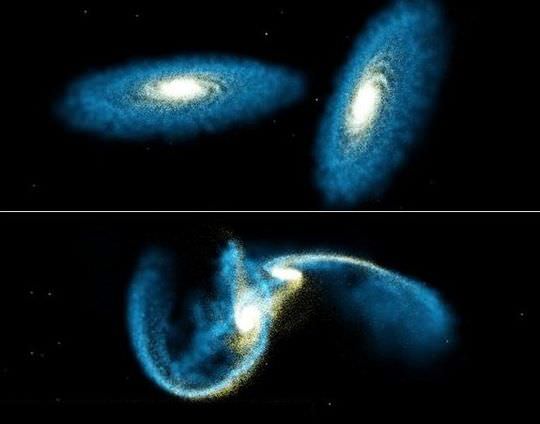Seattle, January, 2003. Two prestigious astronomers: Puragra GuhaThakurta of UCSC and David Reitzel of UCLA present some new findings to the American Astronomical Society that would seem to indicate that large spiral galaxies grow by gobbling up smaller satellite galaxies. Their evidence, a faint trail of stars in the nearby Andromeda galaxy that are thought to be a vast trail of debris left over from an ancient merger of Andromeda with another, smaller galaxy. This process, known as Galactic Cannibalism is a process whereby a large galaxy, through tidal gravitational interactions with a companion galaxy, merges with that companion, resulting in a larger galaxy.
The most common result of this process is an irregular galaxy of one form or another, although elliptical galaxies may also result. Several examples of this have been observed with the help of the Hubble telescope, which include the Whirlpool Galaxy, the Mice Galaxies, and the Antennae Galaxies, all of which appear to be in one phase or another of merging and cannibalising. However, this process is not to be confused with Galactic Collision which is a similar process where galaxies collide, but retain much of their original shape. In these cases, a smaller degree of momentum or a considerable discrepancy in the size of the two galaxies is responsible. In the former case, the galaxies cease moving after merging because they have no more momentum to spare; in the latter, the larger galaxies shape overtakes the smaller one and their appears to be little in the way of change.
All of this is consistent with the most current, hierarchical models of galaxy formation used by NASA, other space agencies and astronomers. In this model, galaxies are believed to grow by ingesting smaller, dwarf galaxies and the minihalos of dark matter that envelop them. In the process, some of these dwarf galaxies are shredded by the gravitational tidal forces when they travel too close to the center of the “host” galaxy’s enormous halo. This, in turn, leaves streams of stars behind, relics of the original event and one of the main pieces of evidence for this theory. It has also been suggested that galactic cannibalism is currently occurring between the Milky Way and the Large and Small Magellanic Clouds that exist beyond its borders. Streams of gravitationally-attracted hydrogen arcing from these dwarf galaxies to the Milky Way is taken as evidence for this theory.
As interesting as all of these finds are, they don’t exactly bode well for those of us who call the Milky Way galaxy, or any other galaxy for that matter, home! Given our proximity to the Andromeda Galaxy and its size – the largest galaxy of the Local Group, boasting over a trillion stars to our measly half a trillion – it is likely that our galaxy will someday collide with it. Given the sheer scale of the tidal gravitational forces involved, this process could prove disastrous for any and all life forms and planets that are currently occupy it!
We have written many articles about galactic cannibalism for Universe Today. Here’s an article about ancient galaxies feeding on gas, and here’s an article about an article, Galactic Ghosts Haunt Their Killers.
If you’d like more info on galaxies, check out Hubblesite’s News Releases on Galaxies, and here’s NASA’s Science Page on Galaxies.
We’ve also recorded an episode of Astronomy Cast about galaxies. Listen here, Episode 97: Galaxies.
Sources:
http://en.wikipedia.org/wiki/Interacting_galaxy
http://en.wikipedia.org/wiki/Andromeda_Galaxy
http://www1.ucsc.edu/currents/02-03/01-13/debris.html
http://blogs.physicstoday.org/update/2009/10/galactic-cannibalism.html
http://news.discovery.com/space/hubble-spiesz-aftermath-of-galactic-cannibalism.html

